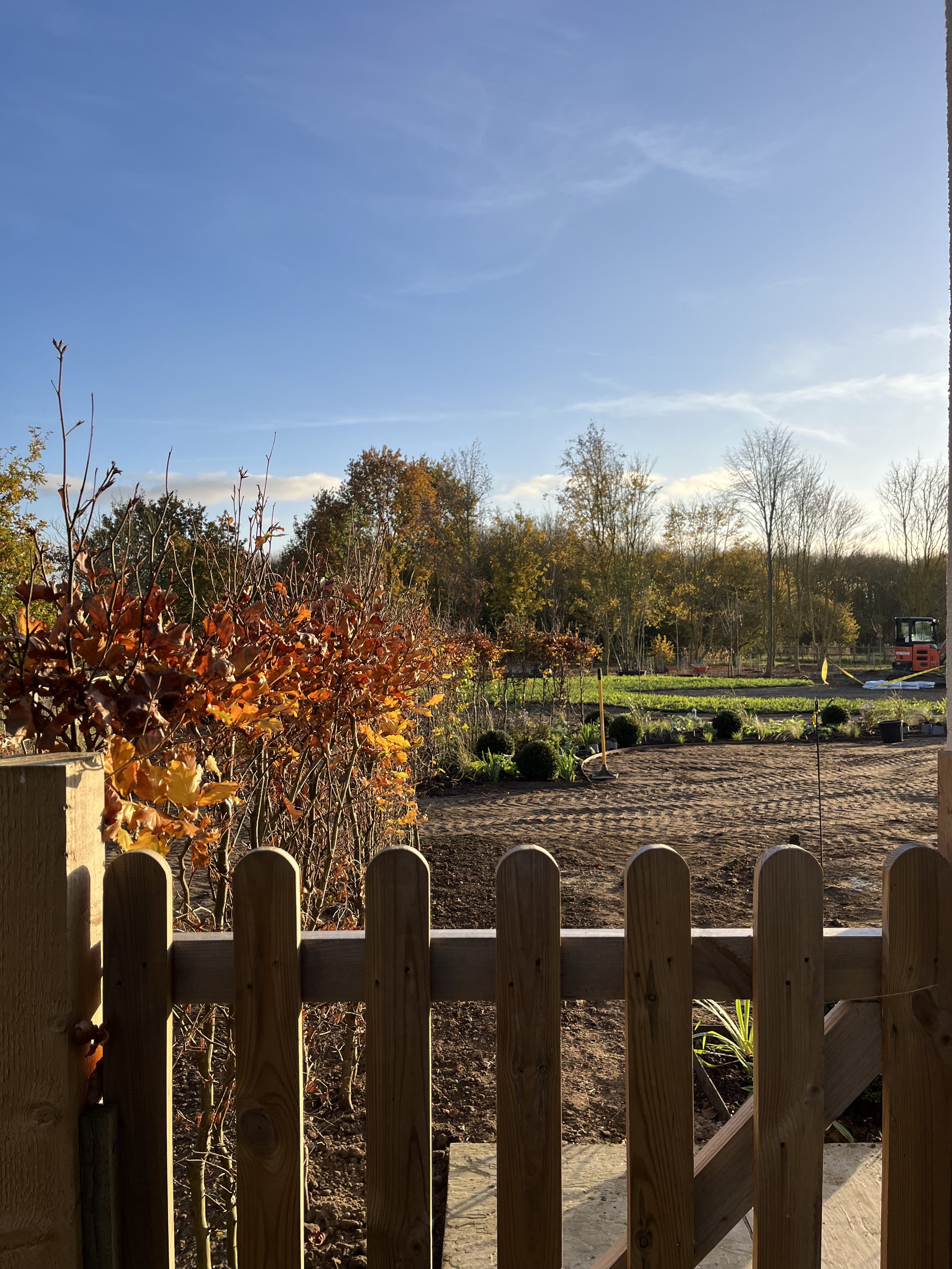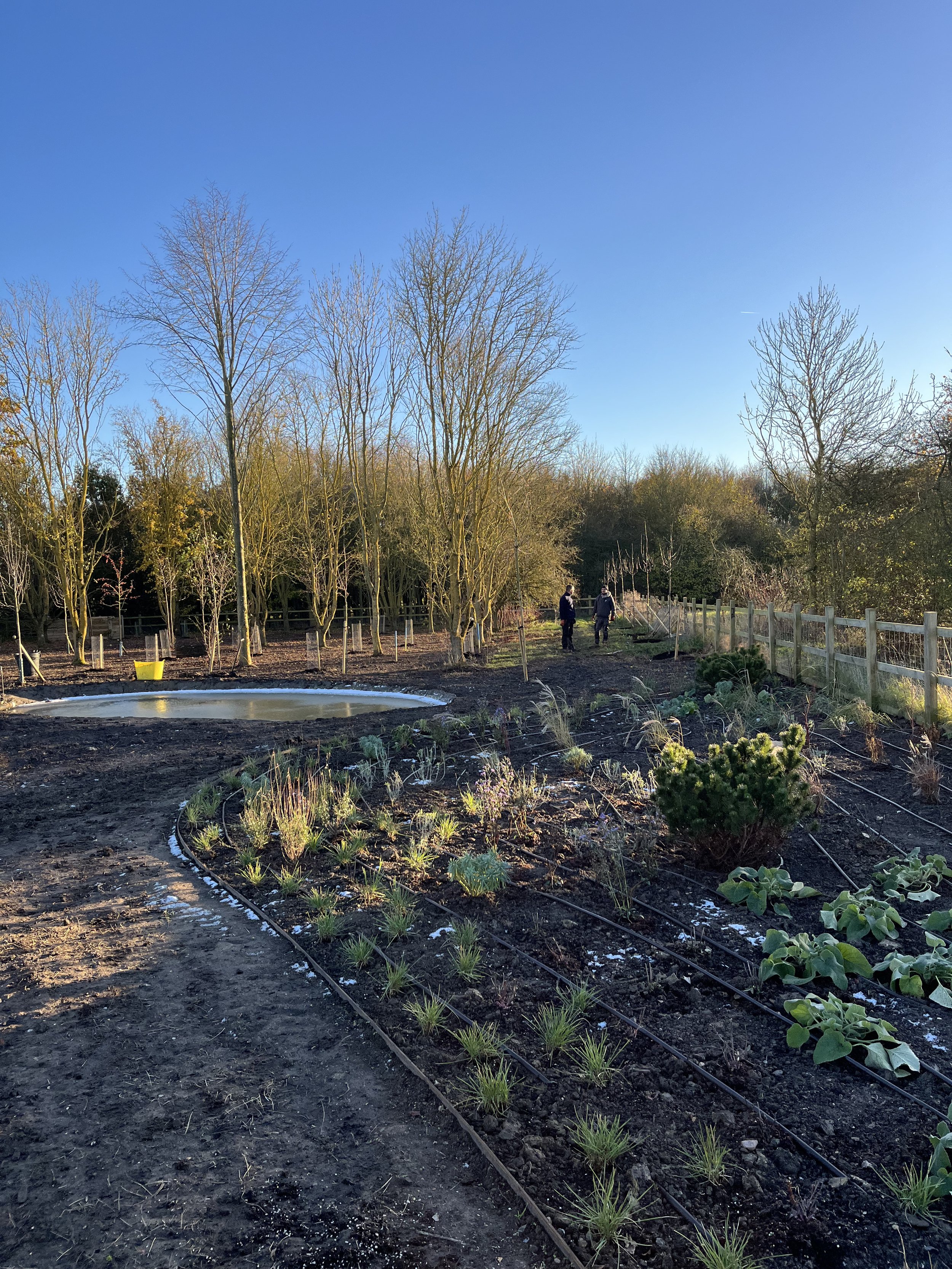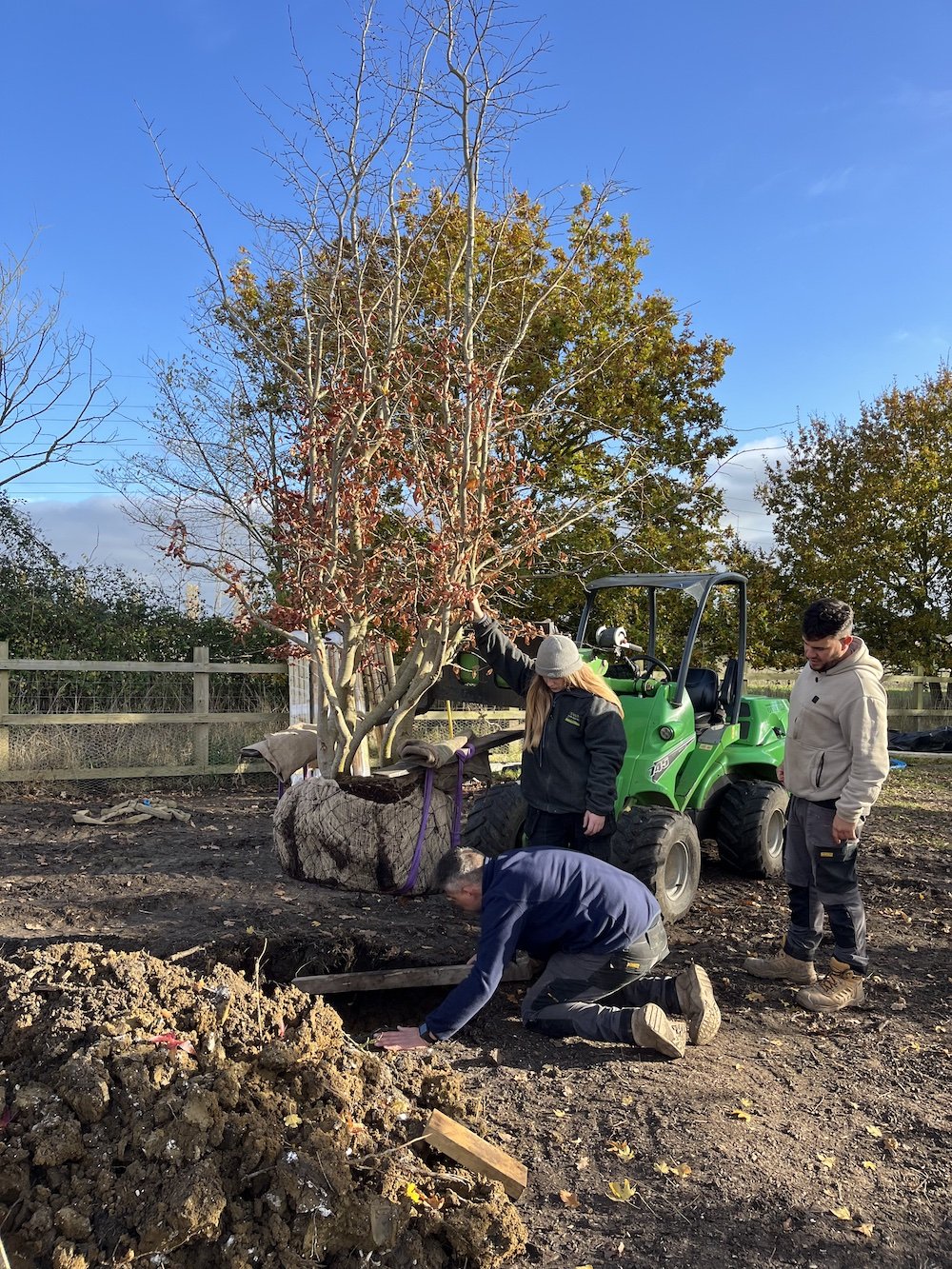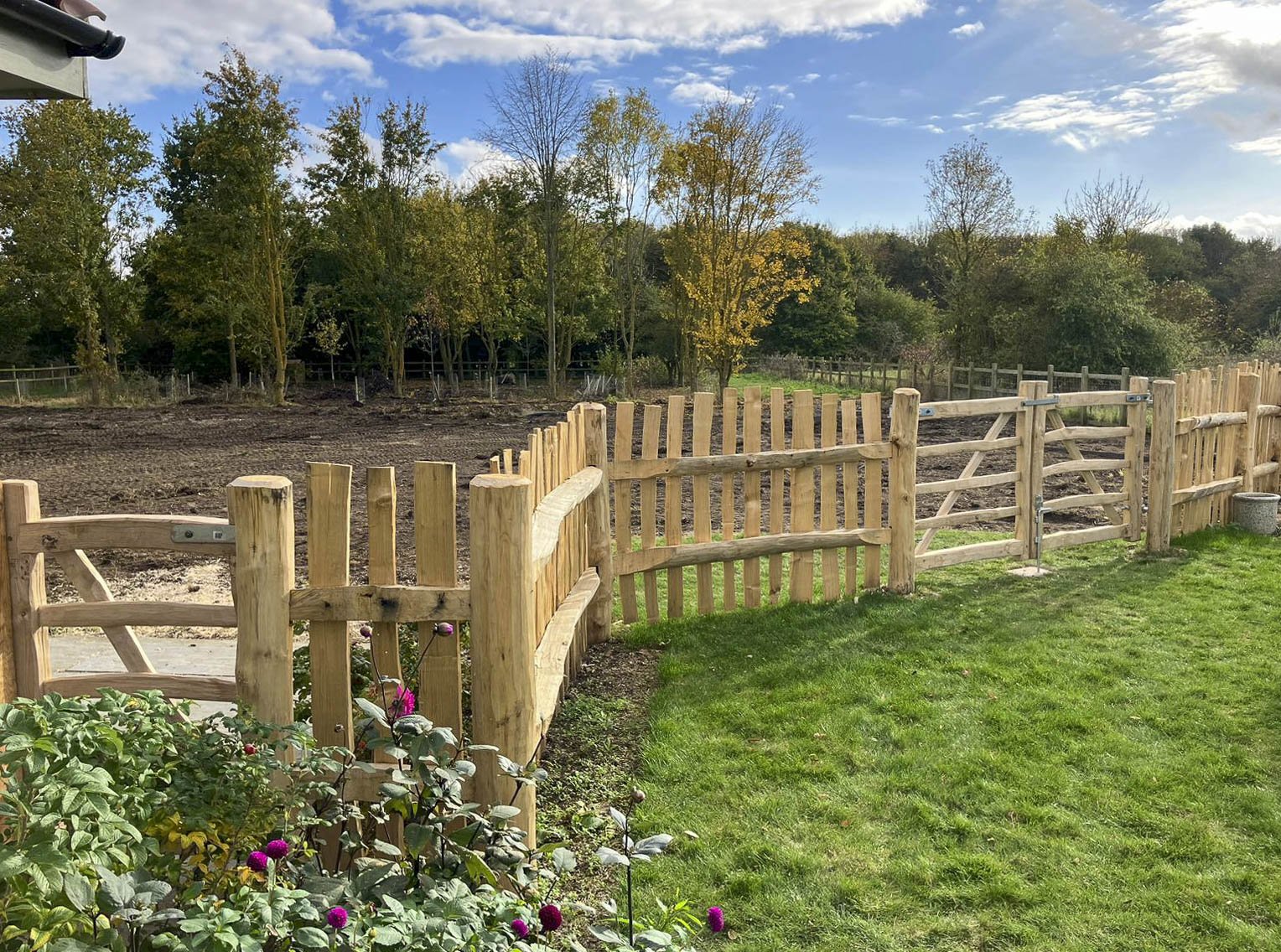lARGE WILDLIFE Garden
Mid Suffolk
Construction completed December 2024
Landscaping contractors: Stewart Landscapes

Wildlife Garden in Suffolk with a large puddled clay pond
The brief was to design a wildlife garden for a new build house, working with a site that had some existing woodland. When I was commissioned, much of the site had already been cleared and the client didn’t want any new hard landscaping. The builders had already created a patio on the south side of the house.

Curves form the basis of the design giving the garden an encompassing and welcoming feel. These photos were taken shortly after planting and before the lawn turf was laid.

View across newly filled pond to woods behind

View from the house down to the pond, shortly after the lawn was laid
Using puddled clay in a new wildlife pond
We have created a large wildlife pond (9m x 5m) that will provide a habitat for a whole ecosystem.
Rather than using a rubber pond liner, which is often the most practical way to make a pond watertight, we have used a natural material called puddled clay.
On the left, you can see the darker layer of puddled clay as it is being installed. On the right, the pond after filling.
What is puddled clay?
Compacted clay, with all the air pockets squeezed out, is called puddled clay. This creates a watertight layer – suitable for lining a pond.
Historically, cattle were driven through the clay-lined area to perform the compacting process. The technique of puddling clay was developed in the 18th century by pioneering canal engineer James Brindley, who was responsible for building 365 miles of canal in Britain.
As the soil in this Suffolk garden is heavy clay, we were hopeful that the naturally occurring clay found on site could be used to line the pond. However, after testing, we found that a high sand content prevented water retention. Instead, we have brought in some puddled clay for pond-lining.
Because this is a pond for wildlife, we are keeping it shallow to allow frogs and newts to easily crawl in and out. At its deepest point, in the centre, the pond is about 90cm. There’s also a marginal shelf at 30cm depth for the pond plants.


It will be important to keep the pond topped up so that the clay doesn’t dry out and crack. As long as it doesn’t dry out, the clay should provide a good watertight lining for years to come.
Note: for gardeners with smaller ponds
Because this is a large pond, puddled clay is an appropriate material.
For smaller bodies of water, like my own wildlife pond, puddled clay wouldn’t be so suitable. A small pond is more likely to dry out completely. Therefore, the risk of the clay cracking and the pond leaking when refilled would be high – especially in an area of low rainfall.
Local context is important to every decision in the garden.
Rainwater harvesting for ponds
To help keep the pond topped up, and to recycle rainwater from the roof of the client’s house, we hooked up a new pipe to a drainpipe. In case of the pond overfilling, we have also installed a drainage pipe to take water out to a nearby drain.

Laying the wildflower turf in late October 2024

Meadow lawn for lower maintenance and habitat creation
In other areas of the garden too, sustainability and habitat creation are at the core of the design. A large section of the lawn will be wildflower turf. Wildflowers provide habitat and a food source for pollinators, birds, bats and other wildlife, promoting a healthier ecosystem.
In addition to the habitat created, wildflower turf requires only one cut a year. In terms of maintenance this is much more sustainable than a conventional lawn.
Autumn is the best time to lay wildflower turf. The cooler temperatures and wetter weather allow the roots of the turf to bed down and establish well – without the turf drying out. By spring there should be a good root system to support a flush of new growth. We used the spoil from digging out the pond to slightly raise the area where the wildflower turf was so that it would drain well in order to suit the wildflowers.
We are using Lindum Wildflower Turf, which is plastic free and uses a biodegradable felt substrate.
The full garden plan, with wildflower meadow-lawn and wildlife pond in the central area.
Prioritising composting and the recycling of garden waste
Before work started on anything else in the garden, we erected three composting bins within the shaded woodland area.
Using these, my client can keep the majority of her green garden waste on site and create her own compost, which will continue to feed and improve the soil in her garden in future years.
From a garden sustainability point of view this means less compost and mulch is brought into the site, because the client will be producing her own.


Hazel and Parrotia persica planting on site.
Planting garden trees benefits wildlife
In the existing woodland area, which will be coppiced, I have already been planting some of the new trees we have chosen. Twenty-seven new Corylus avellana (hazel) trees will create an understorey.
This native hazel supports at least seventy species of insects as well as mammals such as dormice, squirrels and deer.
The hazels were grown from seed locally in a Suffolk nursery – Rymer Trees in Barnham. Stewart Landscapes have planted thirty-one trees in the garden over the last month, including fifteen Betula pendula (silver birch) and five Alnus glutinosa (alder).

Selecting 3 multi-stem Betula pendula trees, the UK's native silver birch, at Deepdale Trees

Centre front: a newly planted alder (Alnus glutinosa) in the woodland area of the garden

The three Betula Pendula planted near the house are a key feature of the new 'courtyard garden'

Planting Day
Native trees to support insect species
The native silver birch trees found in the UK (Betula pendula) provide food and habitat for more than three hundred insect species. This is something to consider if you are choosing a tree – there are many attractive non-native varieties of birches, but these do not support anywhere near the same levels of insect populations.
The birch leaves will attract aphids which provide food for ladybirds and other species further up the food chain. The leaves are also a food plant for the caterpillars of many moths, including the angle-shades, buff tip, pebble hook-tip, and Kentish glory.
Birch trees are particularly associated with specific fungi, including fly agaric, woolly milk cap, birch milk cap, birch brittlegill, birch knight, chanterelle and the birch polypore (razor strop).
Woodpeckers and other hole-nesting birds often nest in the trunk, while the seeds are eaten by siskins, greenfinches and redpolls.
Alder trees (the Alnus glutinosa, which we are planting, is native to the UK) also provide food for the caterpillars of several moths including the alder kitten, pebble hook-tip, the autumnal and the blue-bordered carpet moth. Catkins provide an early source of nectar and pollen for bees, and the seeds are eaten by the redpoll, siskin and goldfinch.
Trees for waterlogged gardens
Unlike my own garden (forty miles away on the border of Essex and Cambridgeshire) which is very dry, the conditions in parts of this Suffolk garden are rather wet.
Alders are perfect here; their wood doesn’t rot when waterlogged – in fact, it turns stronger and harder. Alder woodland provides ideal growing conditions for a number of lichens, fungi and mosses, along with the small pearl-bordered fritillary and chequered skipper butterflies, and some species of crane fly.
Against this backdrop of native trees, we are also planting a selection of ornamental garden trees to provide a feast of berries and crab apples for birds into the winter season: four Crataegus prunifolia (cockspur thorn); nine Malus Hupehensis (tea crabapple); seven Malus toringo ‘Scarlett’ (a purple-leafed crabapple).

Planting plans (details)

Garden borders for pollinators
The borders will include a long season of flowering plants for pollinators. From January and February, bulbs such as snowdrops and aconites will begin an array of flowers that will continue through to late season flowers such as hylotelephiums (sedums) and Symphyotrichum ‘Little Carlow’ (aster).
I have also included lots of grasses that – with the uncut seedheads of perennials such as Phlomis russeliana and Eutrochium maculatum – will provide winter habitat for invertebrates.



The lawn turf went down in mid December and here you can see the bulbs being set out for planting
Traditional fencing handmade from local, sustainable timber
We have also been installing handmade fencing and gates. These are the work of Cambridge craftsman and coppice worker Olly Moses who uses traditional methods and very local, sustainably managed timber.
Olly used Suffolk chestnut, cut from Hawkins Forestry. Located near Bury St Edmunds – under 10 miles away from the garden – Hawkins Forestry manage, plant and maintain ancient coppice woodland. Their work is driven by conservation and sustainability principles.
Rather than using concrete, the fencing posts were installed using a rammed earth method.


A maturing wildlife garden
I’m looking forward to seeing the various habitats that we have created in this garden settle and develop over time. And I also look forward to updates from my client on all the wildlife she starts spotting in her garden – for many years to come.
With enormous thanks to my client for this wonderful commission, and to all at Stewart Landscapes for realising my design.

“This garden means such a lot to me. I will definitely be looking out for all the wildlife. You have certainly created a wonderful space/ garden/ landscape, which will give me so much enjoyment and fulfilment for my retirement. Thank you so much.”





